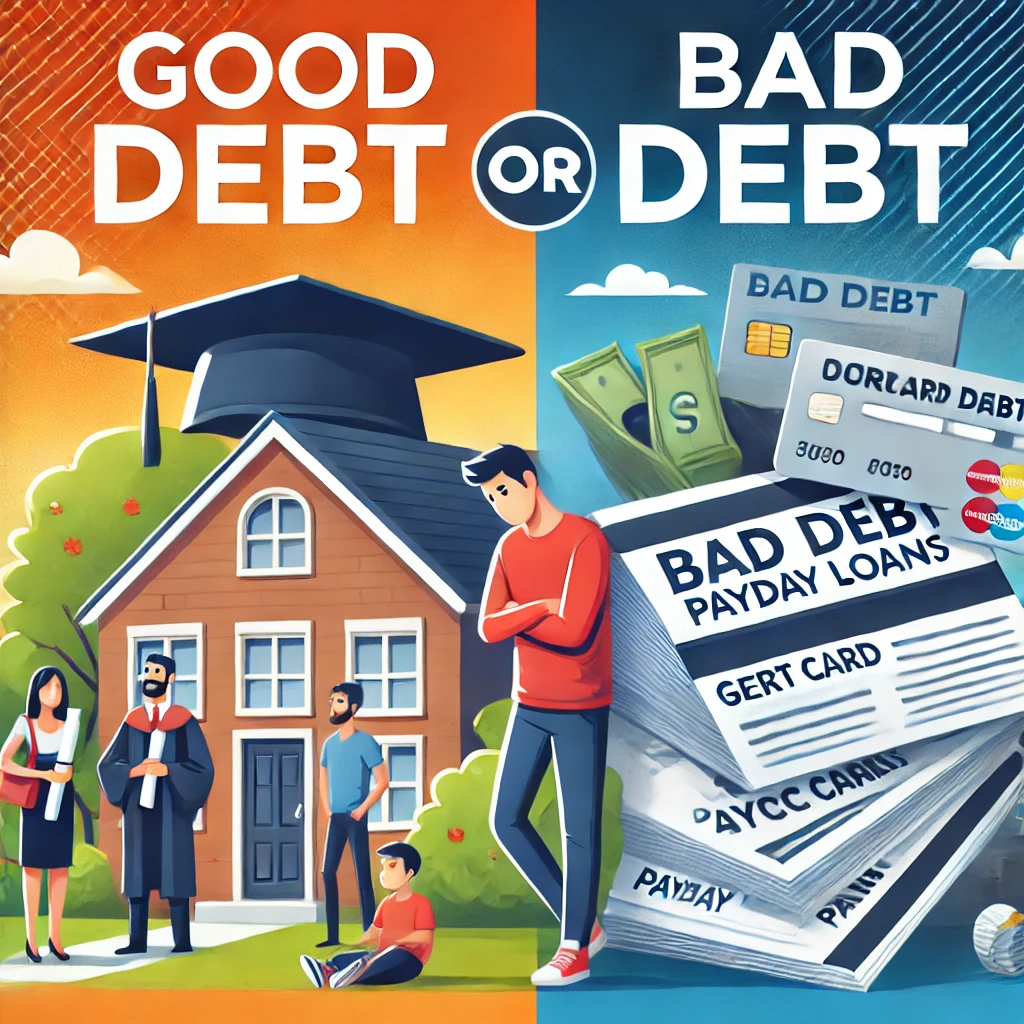Debt is often viewed as a financial burden, but not all debt is inherently bad. Understanding the distinction between good debt and bad debt can help you make smarter financial decisions and leverage debt as a tool to build wealth. Here’s a comprehensive look at good debt vs. bad debt, and how you can manage them effectively.

What Is Good Debt?
Good debt is borrowing that has the potential to improve your financial future. It’s an investment in something that can generate income or grow in value over time. Examples include:
- Student Loans:
- Education is often a stepping stone to higher-paying jobs and career advancement.
- While student loans come with interest, the long-term financial benefits of higher education typically outweigh the cost.
- Mortgages:
- Purchasing a home is an investment in property that often appreciates in value.
- Mortgages allow you to build equity over time, which can be a valuable financial asset.
- Business Loans:
- Borrowing to start or expand a business can lead to increased revenue and profits.
- Business loans can enable entrepreneurs to scale their operations and achieve financial independence.
- Real Estate Investment Loans:
- Loans for rental properties or commercial real estate can provide steady income and long-term appreciation.
Characteristics of Good Debt:
- Has a reasonable interest rate.
- Supports an investment or asset that grows in value.
- Contributes to long-term financial stability.
What Is Bad Debt?
Bad debt is borrowing that offers little or no financial return and often involves high interest rates. This type of debt can trap you in a cycle of payments without building any meaningful value. Examples include:
- Credit Card Debt:
- High-interest credit card balances can quickly spiral out of control.
- Using credit cards for discretionary purchases often results in paying far more than the initial cost.
- Payday Loans:
- Payday loans come with extremely high interest rates and fees, making them one of the most damaging forms of debt.
- They often lead to a cycle of borrowing that’s hard to escape.
- Auto Loans for Expensive Cars:
- Cars depreciate in value over time, meaning you’re paying interest on a depreciating asset.
- Opting for an overly expensive car loan can strain your finances.
Characteristics of Bad Debt:
- High interest rates and fees.
- Used to purchase depreciating assets or non-essential items.
- Does not contribute to long-term financial growth.
How to Differentiate Between Good and Bad Debt
To evaluate whether debt is good or bad, ask yourself:
- Is this debt an investment? Does it have the potential to generate income or increase in value?
- Can I afford the repayments? Will the debt fit into my budget without compromising other financial goals?
- What are the interest rates and terms? Are the terms reasonable, or will the debt grow disproportionately over time?
If the answers to these questions align with your financial objectives and provide a clear benefit, the debt may be classified as “good.” If not, it’s likely “bad” debt.
Tips for Managing Debt Effectively
- Prioritize High-Interest Debt:
- Pay off credit cards and payday loans as quickly as possible.
- Use strategies like the debt snowball or debt avalanche methods.
- Borrow Wisely:
- Only take on debt for investments that align with your financial goals.
- Avoid borrowing for non-essential expenses or luxury items.
- Understand the Terms:
- Before taking on any debt, carefully review the interest rates, fees, and repayment terms.
- Consider consulting a financial advisor if the terms are unclear.
- Build an Emergency Fund:
- Having savings can reduce the need to rely on debt for unexpected expenses.
- Consolidate Debt:
- If you have multiple high-interest debts, consider consolidating them into a single loan with a lower interest rate.
Conclusion
Debt, when used responsibly, can be a powerful tool for achieving financial success. Good debt supports your long-term goals and builds assets, while bad debt drains your resources and limits financial growth. By understanding the difference and managing debt wisely, you can make informed decisions that lead to a more secure financial future.
Remember, the key to effective debt management is maintaining a balance. Borrow strategically, prioritize repayments, and always keep your long-term goals in mind.
Disclosure: This article is for informational purposes only and does not constitute financial advice. Always consult a financial professional for advice tailored to your individual circumstances.
